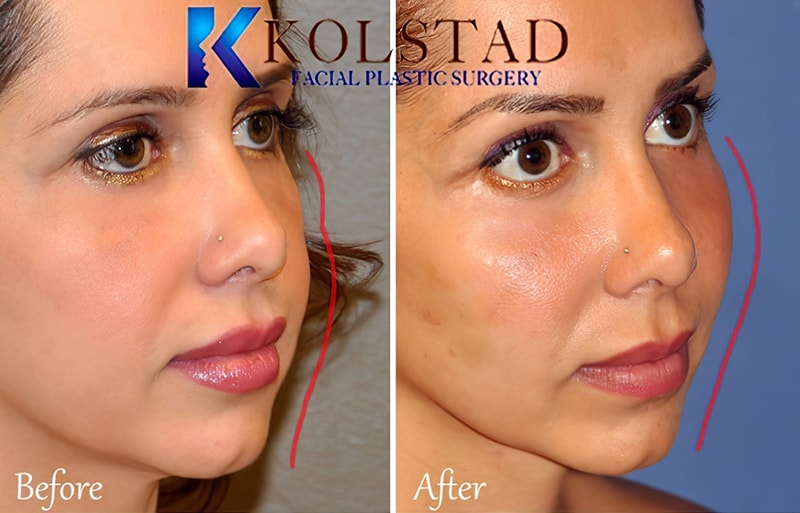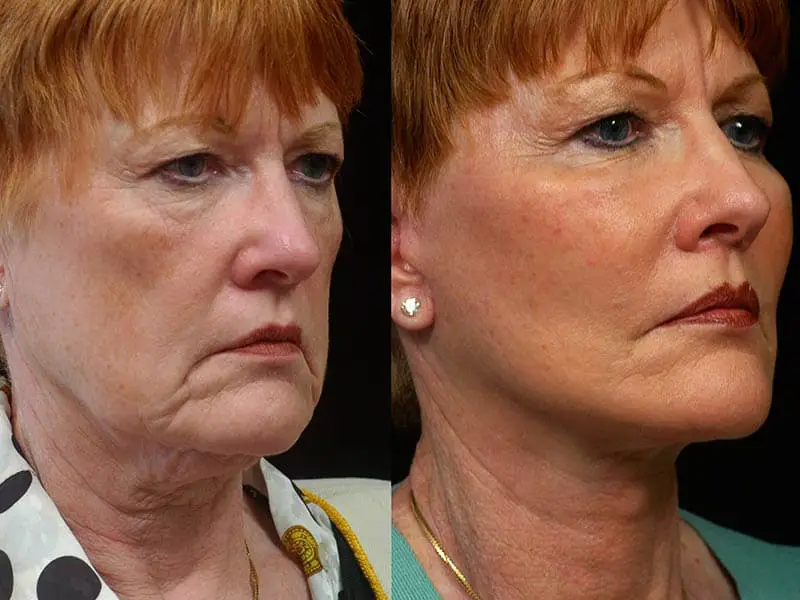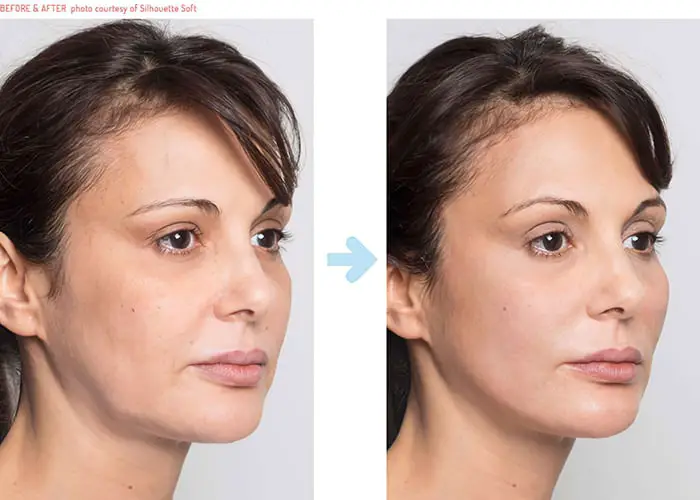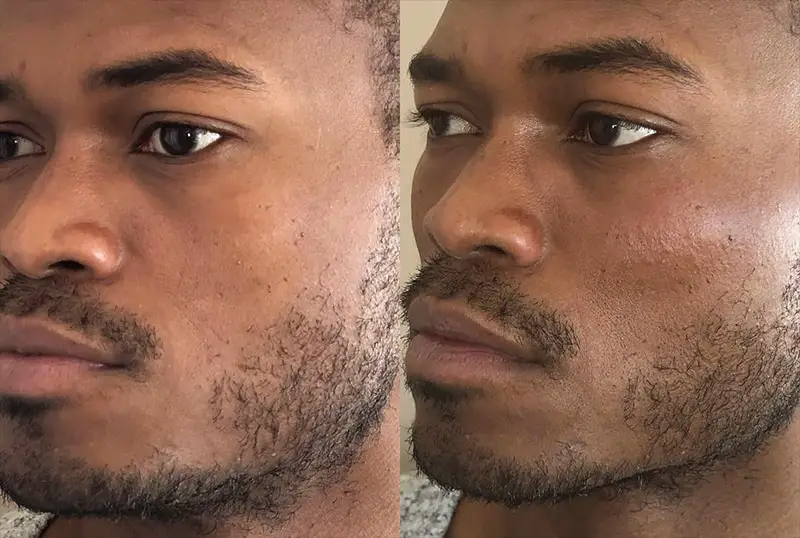
Many people want to get higher cheekbones, whether to get that “supermodel” look or to make themselves look more youthful. However, most people are not sure what type of cheek augmentation procedure will get them high cheekbones.
Common surgeries to get high cheekbones include filler, fat grafting, cheek implants, and thread lifts. Implants will provide the best and longest-lasting results but are the most invasive.
High vs. Low Cheekbones
Keep in mind that when someone says they want “high cheekbones” they’re most likely referring to “prominent cheekbones”. True high cheekbones are rare:

See how her cheekbones start close to eye level? These are true high cheekbones.
Mads Mikaelson on the other hand has low cheekbones. His start closer to the base of his nose:

Almost no surgeries can give you higher cheekbones because it requires shaving off cheekbones that are low, while simultaneously augmenting the cheekbone in some way. You will have to discuss with your plastic surgeon whether he can change your actual cheekbone height.
High cheekbones tend to create a more defined “cheek hollow“. But low cheekbones can accomplish the same thing. What’s more important is whether or not your cheekbones are prominent, which the following procedures can help you with.
Fat Grafting
A fat grafting or fat transfer procedure is ideal for people who want something more permanent than a dermal filler but more natural than traditional cheek implants. Fat implants use a completely natural substance (normally your own thigh or stomach fat) to add volume and height to your cheekbones.
Keep in mind that this procedure will not help you lose lots of fat in the stomach or thigh area. The fat that a surgeon harvests from those areas will not be enough to impact your weight noticeably.

How the Procedure Works
First, a surgeon will perform liposuction into the targeted area. The liposuction will help the doctor retrieve the fat for your cheekbone augmentation. The fat will then get purified for the next step.
The surgeon will inject the fat strategically into your cheek. Your surgeon may “overfill” the area because a bit of fat will get reabsorbed into the body.
Pros
The main pro of a fat transfer is that there is no risk of rejection. Typically, most cheek augmentation involves using a foreign object to enhance the targeted area, which can get rejected by the body. Since you will use fat from your body, your body can’t reject or be allergic to it. Your body will literally grow new blood vessels to support the fat tissue.
Another big benefit of a fat grafting procedure is that it can look more natural and permanent. The fat is often much softer than most synthetic implant material, so it would “blend” into your skin well.
Additionally, the downtime for a fat transfer tends to be minimal. Most patients may need to stay at home for 7-10 days, but some can go back to a relaxed daily life after 48 hours. The majority of the swelling tends to fade after a few weeks when your final results become visible.
Cons
The main con is that fat does not hold its shape well and isn’t good at augmenting sharp areas like cheekbones. It’s better suited for filling in areas of lost volume such as the front of the cheekbone or tear-trough area. Like fillers, it might look good after injection but will “smush” over time, requiring constant touch-ups, which could create problems such as fat migrating to unwanted parts of the face.
Weight loss and weight gain can affect your results because the fat in your face can change. The fat from your fat transfer will be diminished from weight loss or look less defined (especially if your weight gain gave you larger buccal fat pads). On the flip side, if you gain a lot of weight, the fat in your cheeks will grow disproportionately to the rest of your facial fat since it originally came from your belly/hips. Maintaining your weight becomes crucial, and you may need to “touch-up” your cheeks if there is a significant weight change.
Another con is that you will still deal with redness, bruising, and swelling in your face and at the donor site. While this procedure’s recovery time is relatively short, most people will still take around six weeks to make a full recovery.
It is common to feel partial numbness a few days after the surgery. Like most of the other side effects, it tends to lessen or disappear a week after the procedure.
It is also possible to have scars at the donor site, the cheekbone area, or both. Most scars are rather small and tend to fade, but they may not completely go away.
Cheek Implants
Cheek implants are a permanent way to increase your cheek’s projection and volume by mimicking bones. Implants are normally made of solid silicone substances that sit over the cheekbones to create permanent and natural-looking results.
There are three kinds of cheek implants.
- The first is submalar implants, which are right below the lower eye line and where the cheekbone starts. It is ideal for people who want to fix sunken cheekbones.
- The second kind is malar implants, which are right under the submalar area where the cheekbone sits. While it is less common than a submalar implant, younger patients may prefer malar implants because it makes their cheekbones angular and sharper.
- In some cases, a patient may need both kinds of implants, which means they will need a combination. Getting both procedures will help them add volume to their midface while making their cheekbones more defined.

Most people do not have a reaction to the implants. Silicone is an inert substance. Your body will form a capsule around the implant as a normal part of the healing process. It’s theorized that in some individuals, the immune system never stops attacking the implant, which can cause negative side effects, but the chances of that happening are pretty rare. You can always have the implant taken out.
How the Procedure Works
- A surgeon will first administer local or general anesthesia.
- The surgeon will then create a small pocket for the implant by cutting a small incision in the mouth or under the eyes.
- Through the incision, the surgeon will slip the implant in until it is in the correct position.
- The surgeon will then secure the implant to avoid potential slipping.
- The surgeon will use sutures to close the incisions. If the area swells, your surgeon may apply a bandage or compression to reduce the swelling.
Pros
Implants are the best option for mimicking bone and creating realistic results. Your body eventually fuses the implant into place, and it can even withstand some light trauma. Some physicians use 3d modeling software to show you what you’ll look like after the implant is put in, but these should be taken with a grain of salt.
Most cheek implant procedures only take one hour to complete, even if it is a surgery. The procedure tends to be relatively quick, given that there are no complications.
Another big benefit of cheek implants is they last for a long time. If the implant does not slip and there are no other complications, you may only need very few follow-up appointments and minor maintenance.
Cons
Cheek implants tend only to look natural if they sit properly on your cheekbones. If they do not sit properly on the cheekbones, they will look obviously fake.
Another issue some people have with cheek implants is they occasionally slip. An implant that slipped would make your cheekbones asymmetrical and would likely make your cheek augmentation procedure obvious.
While implants are supposed to be permanent, you can always ask a surgeon to remove your implants. However, that would likely mean you need to get another surgery to remove the implants. Plus, you’d look worse than before you got the implant since the presence of the implant would have stretched surrounding soft tissue.
Thread Lift
A thread lift is a procedure that sculpts and lifts the face’s shape. It works by using PDO threads, which are medical-grade and temporary sutures, to lift the skin and make it tauter. It doesn’t actually augment cheekbones, but it can give the appearance of an improved cheekbone shape by lifting the soft tissue.
While it is a popular procedure to remove jowls, enhance the jawline, etc., it is also commonly used to enhance the cheekbones. Most people with sunken cheekbones and “smile lines” may benefit from this procedure.
One study shows that the most common site for face lifting surgery was the jawline (Khiabanloo et al., 2019). However, the midface was a close second.
A thread lift can tighten the skin around your midface, enhancing the way your natural cheekbones look. Plus, it can lift the skin to make the cheekbones look plumper.

How the Procedure Works
The threads have small barbs that grab and lift the skin to achieve the desired result. New fibrous tissues form over the threads to hold the tissue and keep the threads in place.
To perform the procedure, a thin needle is used to insert threads under the skin. Once the threads have been inserted, the surgeon will remove the needle. It is common to feel a slight tightening or pressure under the skin.
Pros
A massive benefit of a thread lift is that the recovery time tends to be minimal. Additionally, you often only need to get local anesthesia for this surgery, so you could likely go home by yourself and avoid round-the-clock care.
Thread lifts are a less invasive procedure. They have a smaller risk of severe bleeding, bruising, and scarring.
Cons
If you have significant volume loss in your cheekbone area, a surgeon may suggest that you get another procedure with the thread lift. For instance, your surgeon may inject dermal fillers into your cheekbones to correct volume loss and perform a thread lift to lift the skin and make it tight.
Additionally, you may also experience some bleeding, swelling, and bruising. You may also feel a slight pain where the thread was placed.
There is also a 15-20% chance that you could get a complication, like dimpling. The complications tend to be minor. Therefore, most complications can be easily corrected.
However, you have to be wary of infection after the surgery. You may need to contact your doctor immediately if you have a fever, persistent headaches, swelling for longer than 48 hours, and discharge (red, brown, black, or green) at the procedure site.
Dermal Filler
Like fat grafting, dermal fillers plump up and lift the targeted area, which can help you get higher cheekbones. Dermal fillers are normally made of natural materials like hyaluronic acid, but semi-permanent and permanent varieties may use more synthetic materials.
Typically, a surgeon may add one cc of filler to each cheekbone and ask you what you think. That way, you can avoid “overdone” cheekbones.
It is very easy for a surgeon to dissolve the filler if you think it is too much. However, it is not easy to precisely remove filler without removing too much of it, so a surgeon will take care to avoid overfilling that area in the first place.

How the Procedure Works
Typically, a surgeon will mix a numbing agent into the filler. Alternatively, a surgeon may apply a topical anesthetic onto the targeted area. The surgeon will then slowly inject the filler into your cheekbone area using a cannula.
The procedure is fairly simple and lasts for around twenty minutes. You should see immediate results after the surgery.
Pros
A huge benefit of dermal fillers is it is a very minimally invasive procedure. The injections often feel like a tiny pinprick, but some people may feel almost nothing.
You will also get immediate results after the procedure. You will be in and out of the surgeon’s office with the final result. Plus, there is virtually no downtime, so you can resume most activities immediately after the procedure.
Many fillers use hyaluronic acid, which is naturally produced by our bodies and impossible to get an allergic reaction from.
Cons
Filler can migrate to other parts of your face without ever being resorbed by the body, even after the bulk of the product gets resorbed. This becomes a problem mainly if you use it repeatedly over and over.
Additionally, most fillers will only be visible for 6-12 months, especially if the fillers are made of natural ingredients. The body will metabolize these materials, so it will naturally decrease in size. Therefore, you would need to get dermal fillers again if you want to maintain your look. If you got a semi-permanent or permanent cheek filler, they would likely last longer. However, it may be a bit more difficult to dissolve the material.
It is also important to note that most dermal fillers cannot give you sharp, angular cheekbones. Dermal fillers typically add volume, but, like fat grafting, they cannot add sharp lines and definition that lasts too long after the initial injection. Dermal filler materials are usually soft and get-like, so they will not hold an angular shape.
While the downtime for dermal fillers is practically none, you will want to be gentle with your face for a few days to let the filler “set” into the cheekbones. You may want to avoid lying on your sides or face and avoid touching your face.
Natural Alternative to Get High Cheekbones
Mewing

If you want a more natural alternative to higher cheekbones, you can opt for mewing. The results will take longer to show, but it is a way to encourage your cheekbones to be more defined naturally.
Mewing involves correcting your tongue posture to add light pressure to your palate. The light pressure on your palate will encourage your midface to move up and forward. Since your cheekbones are part of your midface, they will also move up and forward.
However, you should know that there is much more to mewing than simply correcting your tongue posture. You need to follow the correct chewing method, fix your overall posture, and more.
Click here to check out our ultimate guide to mewing, as well as the scientific background or before/after photos.
It is also important to remember how long it would take to see results. Children are still developing, and their bones are very malleable. So, they may see results within 4-6 months.
Teenagers still have easy to mold bones, and they can see results after 1-2 years. On the other hand, most adults may need to wait 2-4 years to see obvious results. However, adult bones are still malleable, so it could not hurt to try mewing to get high cheekbones naturally. Bones remodel in adults at a rate of 10% per year.


